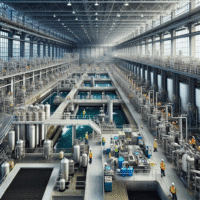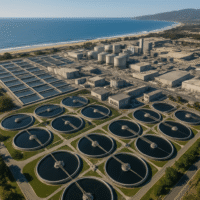Ph Adjustment In Wastewater Treatment

An In-Depth Guide to pH Adjustment in Wastewater Treatment
The balance of pH levels in wastewater treatment plants is crucial for the smooth operation and efficiency of the treatment process. Maintaining an optimal pH level ensures the effectiveness of biological treatments, chemical precipitation processes, and minimizes equipment corrosion. This article will explore the various aspects of pH adjustment in wastewater treatment, providing insights into its importance, methods, technologies, operational challenges, and future trends.
Understanding pH and Its Importance in Wastewater Treatment
What is pH?
The term ‘pH’ stands for ‘potential of Hydrogen,‘ which is a measure of the hydrogen ion concentration in a solution. It indicates whether a solution is acidic, neutral, or basic. The pH scale ranges from 0 to 14, with values below 7 indicating acidity, values above 7 indicating basicity (alkalinity), and a value of 7 indicating neutrality.
Why is pH Important in Wastewater Treatment?
-
- Biological Processes: Many wastewater treatment processes rely on biological organisms to degrade contaminants. Most of these organisms, including bacteria used in activated sludge systems, thrive within a specific pH range (typically 6.5 to 8.5). Deviations from this range can inhibit biological activity, reduce treatment efficiency, and even kill the microorganisms.
-
- Chemical Precipitation: Several chemical precipitation processes are pH-dependent. For example, the removal of heavy metals such as lead, cadmium, and zinc often requires a specific pH level for optimal precipitation.
-
- Corrosion Control: Acidic or highly alkaline conditions can corrode pipes, pumps, and other equipment, leading to increased maintenance costs and potential safety hazards.
-
- Regulatory Compliance: Regulatory agencies impose strict pH limits on wastewater effluent to protect aquatic life and maintain water quality. Non-compliance can result in hefty fines and environmental damage.
pH Adjustment Mechanisms
Acidic and Alkaline Adjusting Agents
To adjust the pH of wastewater, acidic or alkaline agents can be added. The choice of reagent depends on whether the pH needs to be increased or decreased.
-
- Acidic Adjusting Agents: Common agents include sulfuric acid (H2SO4), hydrochloric acid (HCl), and carbon dioxide (CO2). Each has specific pros and cons.
-
- Sulfuric Acid: Widely used due to its efficiency and availability. However, it introduces sulfate ions that might interfere with some processes.
-
- Hydrochloric Acid: Effective and widely available but introduces chloride ions, which can be corrosive.
-
- Carbon Dioxide: Acts as a mild acid and is less corrosive. CO2 dissolves in water to form carbonic acid (H2CO3), which lowers the pH.
-
- Acidic Adjusting Agents: Common agents include sulfuric acid (H2SO4), hydrochloric acid (HCl), and carbon dioxide (CO2). Each has specific pros and cons.
-
- Alkaline Adjusting Agents: Common agents include sodium hydroxide (NaOH), calcium hydroxide (Ca(OH)2), and sodium carbonate (Na2CO3).
-
- Sodium Hydroxide (Caustic Soda): Strong base, effective, but can be dangerous to handle.
-
- Calcium Hydroxide (Lime): Cost-effective and commonly used in large-scale operations.
-
- Sodium Carbonate (Soda Ash): Effective and relatively safe to handle.
-
- Alkaline Adjusting Agents: Common agents include sodium hydroxide (NaOH), calcium hydroxide (Ca(OH)2), and sodium carbonate (Na2CO3).
Buffer Systems
Buffers help to stabilize pH by neutralizing small amounts of acid or base added to the solution. Common buffer systems in wastewater treatment include:
-
- Bicarbonate Buffer System: Involves carbonic acid (H2CO3) and bicarbonate ions (HCO3-), effective in wastewater with high organic content.
-
- Phosphate Buffer System: Involves various forms of phosphoric acid and its salts, effective over a wide pH range but can lead to eutrophication if not properly managed.
pH Adjustment Strategies
Several strategies can be employed to adjust and maintain the desired pH level in wastewater treatment processes. These include:
-
- Continuous pH Monitoring and Control Systems: Automated systems with real-time pH monitoring and proportional control to adjust reagent dosing.
-
- Batch Treatment: Used when dealing with batch processes, involves pH adjustment of individual batches before they are released or processed further.
-
- Equalization Tanks: Temporary storage tanks where wastewater is homogenized, and pH is adjusted before further treatment.
-
- Stepwise Adjustment: Involves sequential addition of reagents, allowing gradual adjustment and preventing overshooting of desired pH levels.
Technologies for pH Adjustment
Sensors and Instrumentation
pH Sensors: Accurate pH measurement is essential for control and adjustment. pH sensors commonly used include:
-
- Glass Electrode: Most widely used, provides reliable and precise measurements; however, it can be fragile.
-
- ISFET (Ion-Sensitive Field-Effect Transistor): More durable and robust compared to glass electrodes but generally more expensive.
-
- Antimony Electrode: Used in highly alkaline or acidic conditions where traditional electrodes might get damaged.
Regular calibration and maintenance of pH sensors are necessary to ensure accurate readings.
Dosing Systems
-
- Peristaltic Pumps: Used for low-flow, precise dosing of reagents.
-
- Diaphragm Pumps: Suitable for handling corrosive chemicals and higher flow rates.
-
- Eductors: Utilize the Venturi effect to mix and disperse chemicals into the wastewater stream.
-
- Gravity Dosing Systems: Cost-effective and suitable for large-scale operations, although less precise than mechanical pumps.
Mixing Systems
Effective mixing ensures uniform reagent distribution and pH adjustment. Common mixing systems include:
-
- Static Mixers: Utilize internal baffles to create turbulence and mix reagents with wastewater without moving parts.
-
- Mechanical Stirrers: Motor-driven paddles or propellers provide active mixing.
-
- Pneumatic Mixing: Air injection creates bubbles and turbulence for mixing, often used in aeration tanks.
Operational Challenges
Reagent Handling and Safety
Handling and storage of acidic and alkaline reagents pose several safety challenges:
-
- Acids: Can cause severe burns and inhalation hazards. Proper storage, ventilation, and handling procedures are necessary.
-
- Bases (Alkaline Agents): Similarly, can cause burns and respiratory hazards. Personal protective equipment (PPE) and dilution procedures are critical.
Scalability and Cost
-
- Scalability: The pH adjustment method must be scalable to handle varying wastewater volumes and flow rates.
-
- Cost: Chemical costs, equipment maintenance, and manpower are significant factors. Optimizing reagent usage and minimizing waste can reduce operational costs.
Sludge Production
Certain pH adjustment processes, especially those involving lime or other precipitating agents, result in sludge production. Managing and disposing of this sludge can be challenging and costly.
Environmental Concerns
Excessive use of chemicals in pH adjustment can introduce secondary pollutants into the wastewater, like sulfates from sulfuric acid or chlorides from hydrochloric acid. Understanding the long-term environmental impact is crucial.
Real-time Monitoring and Control
Achieving precise pH control in a dynamically changing environment requires robust monitoring and real-time adjustments. Variations in influent wastewater characteristics can complicate achieving consistent pH levels.
Case Studies
Municipal Wastewater Treatment Plant Case Study
A municipal treatment plant dealing with varying pH levels due to industrial discharges implemented an automated pH adjustment system. The system included continuous pH monitoring using glass electrode sensors and proportional reagent dosing using diaphragm pumps.
Objectives:
-
- Maintain pH levels between 6.5 and 7.5.
-
- Reduce operational costs and compliance-related fines.
Results:
-
- Achieved consistent pH levels within the desired range.
-
- Reduced chemical usage by 20% through optimized dosing.
-
- Improved regulatory compliance and minimized fines.
Industrial Wastewater Treatment Plant Case Study
An industrial plant discharging highly acidic wastewater from a mining operation faced challenges in maintaining pH and managing sludge production. They employed a stepwise pH adjustment strategy using lime and sodium hydroxide.
Objectives:
-
- Neutralize highly acidic wastewater (pH 2-3) to a neutral range (pH 6-8).
-
- Minimize sludge production.
Results:
-
- Successfully neutralized acidic wastewater to desired pH levels.
-
- Developed sludge management and dewatering systems to handle the increased sludge production.
-
- Implemented a closed-loop system to recycle and reuse neutralized water, reducing overall water consumption.
Future Trends and Innovations
Advanced Sensor Technologies
Advancements in sensor technology are improving the accuracy and durability of pH monitoring systems. Innovations include:
-
- Optical pH Sensors: Utilize light-based measurements, reducing maintenance requirements.
-
- Graphene-based Sensors: Offer increased sensitivity and faster response times.
-
- Wireless Sensor Networks (WSNs): Facilitate remote monitoring and data collection.
AI and Machine Learning
Artificial Intelligence (AI) and Machine Learning (ML) are increasingly being applied to wastewater treatment processes, including pH adjustment.
-
- Predictive Analytics: AI systems can predict pH fluctuations based on historical data and make preemptive adjustments.
-
- Optimization Algorithms: Machine learning algorithms can optimize reagent dosing and mixing to minimize costs and improve efficiency.
Green and Sustainable Reagents
The development and use of environmentally friendly reagents for pH adjustment are gaining traction.
-
- Biodegradable Acids and Bases: Reducing secondary pollution and sludge production.
-
- Natural Buffer Systems: Utilizing natural buffering agents like biochar or zeolites to stabilize pH.
Integrated Treatment Systems
Future wastewater treatment systems are likely to integrate multiple treatment processes, utilizing synergy between different methods for enhanced efficiency.
-
- Hybrid Systems: Combining biological and chemical treatments with advanced oxidation processes (AOPs) for superior contaminant removal and pH control.
-
- Modular Treatment Plants: Flexible and scalable systems that can be easily adjusted to accommodate changes in wastewater characteristics and treatment requirements.
Conclusion
pH adjustment is a fundamental and complex aspect of wastewater treatment, essential for the optimal functioning of biological and chemical processes, equipment longevity, and regulatory compliance. By understanding the underlying mechanisms, employing effective technologies, addressing operational challenges, and staying abreast of future trends, wastewater treatment professionals can ensure the efficient and environmentally responsible management of pH levels. As technology continues to evolve, the field will undoubtedly witness further innovations, driving enhanced sustainability and efficacy in wastewater treatment.
Whether dealing with municipal, industrial, or specialized wastewater streams, mastering pH adjustment is a critical skill that enhances overall treatment performance and contributes to global environmental protection efforts.



